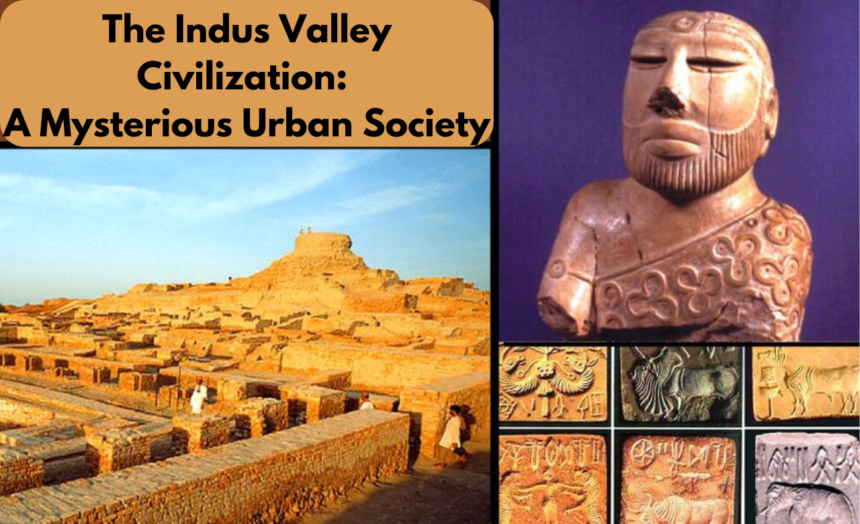The Indus Valley Civilization, one of the world’s earliest and most advanced urban cultures, flourished along the Indus River in what is now modern-day Pakistan and northwestern India.
Despite its remarkable achievements, much about this ancient society remains shrouded in mystery, making it a fascinating subject of study for historians and archaeologists.
A Flourishing Urban Culture
The Indus Valley Civilization thrived between 3300 BCE and 1300 BCE, leaving behind a rich archaeological record. The two most prominent cities of the civilization were Harappa
and Mohenjo-daro, which boasted sophisticated urban planning, advanced engineering, and a complex social structure.
These cities featured well-planned streets, drainage systems, granaries, and public baths, showcasing the high level of development achieved by the Indus Valley people.
- Urban planning: The Indus Valley Civilization had well-planned cities with organized streets and public facilities.
- Advanced engineering: The civilization was known for its sophisticated drainage systems and granaries.
- Complex social structure: The Indus Valley people lived in a hierarchical society with a ruling class, priests, artisans, and farmers.
A Mysterious Script
One of the enduring mysteries of the Indus Valley Civilization is its writing system. While thousands of inscriptions have been found, the script remains undeciphered, making it difficult to understand the language and culture of the people who created it.
Despite numerous attempts to decipher the script, it has so far resisted all efforts.
- Undeciphered script: The Indus Valley script remains a mystery, hindering our understanding of the civilization’s language and culture.
- Numerous attempts at decipherment: Many scholars have tried to crack the code of the Indus Valley script, but without success.
- The mystery adds to the allure of the civilization: The unsolved puzzle of the script continues to intrigue and fascinate researchers.
A Thriving Trade Network
The Indus Valley Civilization was a prosperous society with a thriving trade network that extended far beyond its borders. Archaeologists have discovered evidence of trade with other ancient civilizations, such as Mesopotamia and the Persian Gulf.
The Indus Valley people were skilled artisans and craftsmen, producing a wide range of goods, including pottery, jewelry, and textiles.
- Extensive trade network: The Indus Valley Civilization traded with other ancient civilizations.
- Skilled artisans and craftsmen: The civilization produced a variety of high-quality goods.
- Economic prosperity: Trade and commerce played a significant role in the Indus Valley Civilization’s economy.
A Mysterious Decline
Despite its achievements, the Indus Valley Civilization mysteriously declined around 1900 BCE. The exact reasons for its decline remain unclear, but several theories have been proposed, including environmental changes, social unrest, and invasion by foreign forces. The decline of the Indus Valley Civilization marked the end of one of the world’s earliest and most advanced urban cultures.
- Mysterious decline: The reasons for the decline of the Indus Valley Civilization are still debated.
- Environmental changes: Some theories suggest that environmental factors, such as climate change or flooding, contributed to the decline.
- Social unrest or invasion: Other theories point to internal conflicts or external invasions as possible causes.
The Indus Valley Civilization continues to captivate the imagination of scholars and the public alike. Despite the many mysteries that surround this ancient society, the archaeological evidence provides a glimpse into the lives and achievements of its people.
Glossary
- Indus Valley Civilization: An ancient urban civilization that flourished along the Indus River in what is now modern-day Pakistan and northwestern India.
- Harappa and Mohenjo-daro: Two of the most prominent cities of the Indus Valley Civilization.
- Cuneiform: A system of writing used by the ancient Sumerians and Akkadians.
- Archaeology: The study of human past through the analysis of material remains.
- Indus Valley script: The undeciphered writing system used by the Indus Valley Civilization.
- Trade network: A system of interconnected trade routes and relationships.
- Artisan: A skilled worker who produces goods by hand.
- Decipher: To decode or interpret a written or coded message.
FAQs
Q: When did the Indus Valley Civilization exist?
A: The Indus Valley Civilization flourished between 3300 BCE and 1300 BCE.
Q: What were the two main cities of the Indus Valley Civilization?
A: The two main cities of the Indus Valley Civilization were Harappa and Mohenjo-daro.
Q: What do we know about the Indus Valley people?
A: The Indus Valley people were a sophisticated urban civilization with advanced planning, engineering, and social structures. They were skilled artisans and traders, and they had a complex system of writing.
Q: Why is the Indus Valley script still undeciphered?
A: The Indus Valley script is unique and unlike any other known writing system, making it difficult to decipher.
Q: What are some of the achievements of the Indus Valley Civilization?
A: The Indus Valley Civilization was known for its advanced urban planning, sophisticated engineering, and thriving trade network. They also developed a unique system of writing and produced a variety of artifacts and goods.
Q: What led to the decline of the Indus Valley Civilization?
A: The exact reasons for the decline of the Indus Valley Civilization remain unclear, but several theories have been proposed, including environmental changes, social unrest, and invasion by foreign forces.
Q: What can we learn from the Indus Valley Civilization?
A: The Indus Valley Civilization offers valuable insights into the development of early urban civilizations and the complexity of human societies. It also highlights the importance of preserving our cultural heritage and understanding the past to inform our future.

